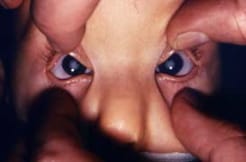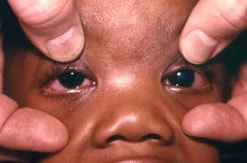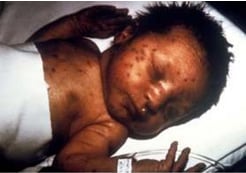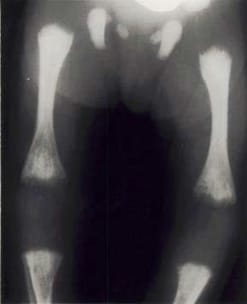Congenital Infectious Syndromes: Congenital Rubella Syndrome
This quick reference handbook presents common congenital infectious conditions during pregnancy that contribute to the burden of birth defects, stillbirths and neonatal deaths – namely, congenital rubella syndrome (CRS), congenital syphilis, congenital cytomegalovirus (cCMV) infection and congenital Zika syndrome (CZS). Vaccination, prompt detection and treatment, and other preventive strategies can reduce the number of adverse pregnancy outcomes (birth defects, miscarriages, stillbirths and neonatal deaths) resulting from congenital infections. Surveillance can assess the national and international burden of maternal infection and adverse infant outcomes, and formulate strategies to reduce transmission from the mother to the fetus.
For each congenital infection, information on the background of the infectious agent, the clinical manifestations in the mother and the infant, photographs, case definition, and the relevant international classification of codes from the International Statistical Classification of Diseases and Related Health Problems, Tenth Revision (ICD-10) that could be used for surveillance are presented. As part of the documentation and improved description of these conditions, each section also includes a checklist of items that need to be done as part of the management of a suspected case with a congenital infectious syndrome.
When infection during pregnancy is clinically suspected, laboratory tests to detect congenital infection might include those for cytomegalovirus (CMV), herpes simplex virus, rubella, HIV, toxoplasmosis, syphilis and Zika virus. Prospective mother–infant linked surveillance coupled with birth defects surveillance can provide a more complete picture of these infections and the outcomes associated with them.
CONGENITAL RUBELLA SYNDROME (CRS)
Background
CRS is the infection of a fetus with rubella virus following the infection of the mother during pregnancy, causing a constellation of malformations. The most critical period to contract CRS is around the time of conception and in early pregnancy (8–10 weeks), when the risk of CRS is as high as 90% or can even result in miscarriage or stillbirth. In cases when the rubella infection occurs after 18 weeks of gestation, the fetus is infected but does not develop CRS.
Main clinical manifestations in the mother
The incubation period of rubella virus infection is 14 days (range, 12–23 days). Clinical symptoms include mild illness with low-grade fever (<39 °C), headache, conjunctivitis and rhinitis. A characteristic feature is post-auricular, occipital and posterior cervical adenopathy (swelling of the lymph nodes), which precedes a red, maculopapular rash by 5–10 days. The rash occurs in 50–80% of rubella-infected persons, begins on the face and neck, and progresses to the lower parts of the body, lasting about three days. In 70% of women, joint pain (arthralgia) also occurs.
Main clinical manifestations in the infant
If primary rubella infection occurs during pregnancy, the virus can infect the placenta and fetus, causing a constellation of specific malformations labelled CRS. The classic triad of clinical manifestations associated with CRS among surviving neonates are hearing impairment; congenital heart defects – in particular, branch pulmonary artery stenosis and patent ductus arteriosus; and eye anomalies such as cataract(s), pigmentary retinopathy (salt and pepper type), chorioretinitis or congenital glaucoma. Additional clinical signs include skin purpura (blueberry muffin skin lesions), splenomegaly (enlargement of the spleen), microcephaly (small head circumference), developmental delay, meningoencephalitis, low birth weight, radiolucent bone disease and jaundice within 24 hours after birth (see Figures below). The periconception period and early pregnancy (8–10 weeks) are the most vulnerable time frames and pose the greatest risk of CRS, which is as high as 90%. CRS can result in fetal death. For infants with CRS, hearing impairment, eye symptoms and developmental delay might not be detected until later.
If maternal rubella infection is diagnosed beyond 18 weeks of gestation, the fetus might be infected but does not typically develop signs and symptoms of CRS. Infants with laboratory evidence of rubella and without any signs or symptoms of CRS are classified as having congenital rubella infection (CRI) only.
Fig.53. Clinical findings in the infant

Infant with typical cloudiness of the eye lenses; that is, cataracts, in a case of CRS.
Photograph source: CDC public health image library/Dr Andre J. Lebrum

Congenital glaucoma (and cataract) in a seven-month-old infant with CRS. The left eye displays a congenital cataract; the right eye is normal. The infant was operated on day 3 of life to correct the congenital cataract.
Photograph source: CDC public health image library/Dr Andre J. Lebrum

Infant with congenital rubella and “blueberry muffin” skin lesions. Lesions are sites of extramedullary hematopoiesis and can be associated with several different congenital viral infections and hematologic diseases.
Photograph source: CDC public health image library/Dr Andre J. Lebrum.

Radiolucent bone disease. X-ray of the lower limbs in a newborn with CRS. The ends of the long bones are ragged and streaky (like celery stalks) – changes due to active rubella infection.
Photograph source: Government of Canada web page (Public health/ Rubella).
Relevant ICD-10 codes
P35.0 Congenital rubella syndrome (CRS)
Q02 Microcephaly
Q12.0 Congenital cataract
Q15.0 Congenital glaucoma
Q25.0 Patent ductus arteriosus
Q25.6 Stenosis of pulmonary artery
Checklist
| Checklist |
|